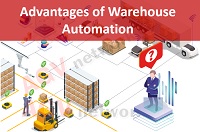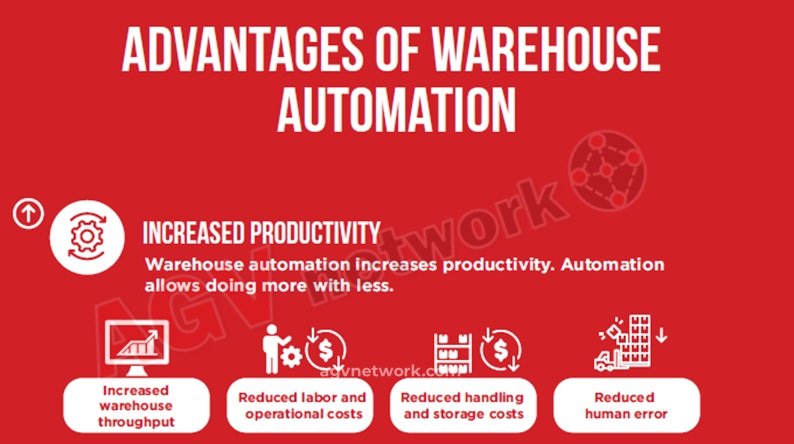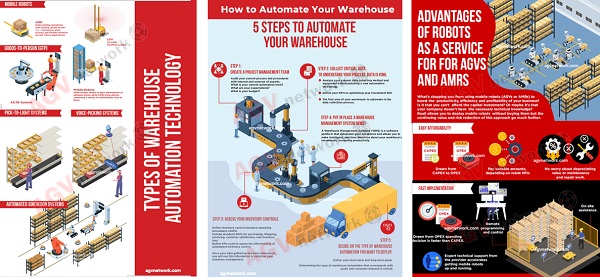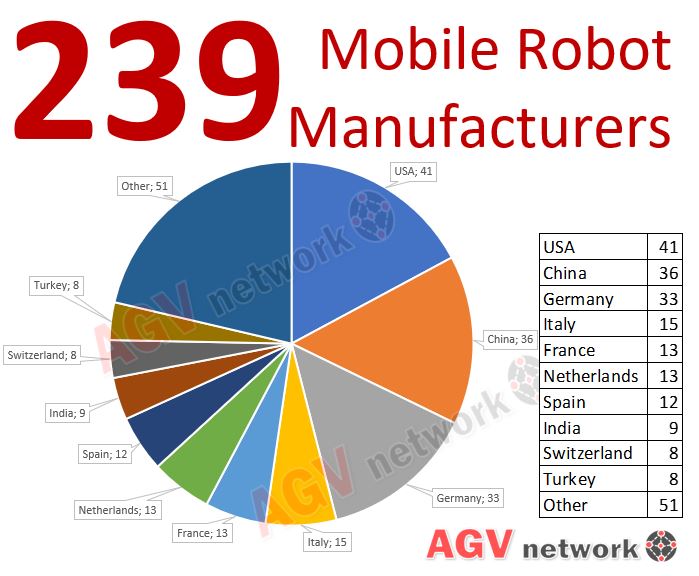20 Untold Benefits of Warehouse Automation

There is no other way to look at it. We must consider the price. Productivity, efficiency, availability, performance, etc. are all acceptable synonyms. To make it in this world, you must be competitive.
Due to the increasing competition in today’s global market, businesses are obliged to improve their supply chains to reduce non-value-added activitues and and enhance customer service levels.
Warehouses in the modern world have become a "battlefield" in the pursuit of this ideal of competitiveness. Warehouses are now the administrative hubs for many supply chain processes, not just for storing inventory.
However, the complexities of warehousing are rising.
- Customization: Product variety tends to increase from time to time and thus adding complexity to warehouse operations.
- Customer expectations: We all love prompt Shipping. "I need it right now.

Warehouse managers must deal with three major inconveniences:
- Finding and retaining capable, trustworthy employees
- Enhancing the Workplace's Productivity
- Limiting labor costs.
There are many warehouse automation trends aiming to alleviate, if not entirely eliminate, these difficulties.
|
Do not forget to check these articles: |
What are the main advantages of warehouse automation?
- Increased productivity
- Reduced direct labor cost
- Reduced handling cost
- Increased warehouse throughput
- Reduced human error
- Increased traceability
- Improved Inventory accuracy
- Reduced stockout events
- Mitigates workforce shortages effect
- Improved employee satisfaction
- Technology makes jobs more appealing and exciting
- Higher workforce retention rates
- Increased Safety
- Less worker strain and fatigue
- Reduced indirect costs
- Optimized warehouse space
- Improved Customer Satisfaction
- Fewer shipping errors
- Improved customer service
- Faster Deliveries
Warehouse automation provides numerous advantages that lead to more efficient and productive operations.
Some general benefits of warehouse automation include increased productivity, efficiency, better employee satisfaction, increased inventory control, and improved customer satisfaction.
Let's take a look to the most important ones.... but before.... do not forget to download the 54 pages "WAREHOUSE AUTOMATION GUIDE" .... there's a lot of additional info and illustrations that you will not find in this article.

| Download The Warehouse Automation Guide |
How does warehouse automation increase productivity?
Simply put, productivity is a measure of economic performance that compares the amount of goods and services produced (output) with the number of inputs used to produce those goods and services.
Warehouse automation increases productivity. Automation allows doing more with less.
- Reduced direct labor cost
- Reduced handling cost
- Increased warehouse throughput
- Reduced human error
How does warehouse Automation reduce direct and handling costs?
Clearly, automation intends to substitute non-value-added operations performed by operators.
If you install a new automation technology, you will immediately calculate how many staff you can move from non-valued tasks to value-added operations complex activities.
The more operators you can substitute (or move), the more convenient it becomes automation.
Let me just show you the average hourly earnings of all employees, warehousing and storage in the US (check: https://www.bls.gov/ )

The average cost of an operator in the United States is between $22 and $23 per hour, but the trend is truly frightening.
Yes, we don't have a crystal ball, so we can't predict how long this trend will last, but based on this graph, it's easy to see why more and more decision makers prefer automation over manual operations.
Consider a traditional warehouse where operators walk or drive a forklift in search of products to be picked.
On average, this “dead time” or better to say "unproductive time" represents around 60% of working hours.
As indicated, the average cost of an operator is $22/hour, it means that you are trashing more than $13/hour for each operator.

If you have 20 operators, you are unnecessary expending $2000 per shift.
So, why not to change the concept? Wouldn’t be better if “goods come to persons”.
Yes, it is the Good-to-person strategy, where the operator does not move (or move in a limited area) and robots brings material for manual picking.
In fact, there are several warehouse automation technologies like AS/RS and Mobile Robots conceived to eliminate pickers or forklifts running up and down aisles to and search for stored items.
Installing one of these systems can cut labor requirements by as much as 66%, enabling current employees to be reassigned to more value-added work while easing hiring pressures and labor expenses.
|
Check these articles: |
How does automation improve warehouse throughput?
Warehouse Automation involves software and technology like robotics solutions and sensors to automate processes.
The target is to reduce time, cost, enhance deliveries, reduce stock, improve operators working environments, etc.
If you apply all the available robotic and software technologies, your warehouse can optimize an existing labor force, increasing productivity from 200% to 300%.
Does Warehouse Automation help to reduce human error?
Yes, it does. Please, don’t get offended if I say that humans make mistakes.
Automated systems don’t get distracted or fatigued, they can work 24h around the clock.
If the automation system is properly conceived and programmed, there will be no mistakes.
On the other hand, various human errors could happen in warehousing operations that in turn would affect the supply chain performance.
Errors in identifying product could end up in picking the wrong item and lead to customer orders being wrongly fulfilled.
Errors in placing items inside the warehouse would ultimately lengthen the searching time during the picking process.
Various errors could also happen in the administrative activities, such as wrong item numbers selection during order acquisition and information transfer.
Automation helps to avoid or reduce human errors, here below some examples:
- Limit Touches. The fewer touches needed to complete a process the fewer chances there are for human error.
- Barcode or RFID Scanning for material tracking and reducing human error due to recording the incorrect information.
- Workflow automation. When workflows are automated, there will be mandatory requirements before moving onto the next step what will eliminate any errors due to skipping a step.
- Optimize Warehouse Layout. A good WMS can use Artificial Intelligence to optimize your warehouse layout. The WMS can make informed suggestions on how to organize your warehouse.
- Automation avoids the possibility of an employee storing inventory in the wrong place.
Accordingly with The Data Warehouse Institute, upwards of $600 billion every year can be attributed to data entry errors in the supply chain, data procurement, and other vital areas, exposing organizations to compliance risks in addition to a large amount of wasted money and resources.
How does warehouse automation improve traceability and accuracy?
An automated warehouse integrates many different hardware and software systems leading to:
- Increased traceability
- Improved Inventory accuracy
- Reduced stockout events
Thanks to RFID systems or mobile robots you can always know the material and inventory status in real-time.
For example, mobile robots or warehouse drones systems can be integrated with a MES, WMS, ERP, allowing to combine all the product life, from the order to the delivery, interacting with logistics and production processes to enhance operational efficiency.
Businesses can avoid wasting time on manual inventory tracking, avoid costly mistakes, and guarantee delivery on time.
The advantages of a system like this for a warehouse include:
1) increasing warehouse storage capacity through automatic shelf modifications and demand analysis of available storage space;
2) streamlining warehouse management by facilitating inventory business activities such as material requisition and procurement; and
3) gaining complete control through user-based permission configuration, adaptable management strategies, and warehouse visualization
Warehouse Automation improves the working environment
Warehouse automation offers several benefits that make working environments more pleasant and safer.
- Mitigates workforce shortages effect
- Improved employee satisfaction
- Technology makes jobs more appealing and exciting
- Higher workforce retention rates
- Increased Safety
- Less worker strain and fatigue
According to the US Bureau of Labor Statistics (BLS), in the last years the Warehousing and Storage sector of the US economy grew dramatically driven largely by a rising economy and increased ecommerce sales across the country.

Unfortunately, this massive growth in hiring and demand for workers has come with a number of significant downsides.
One of the most critical of these is the fact that the warehousing and order fulfilment industries are experiencing a significant labor shortage, which threatens this continuation of this growth.
|
“5.5 million more job openings than there are workers available to fill them” according to the Labor Department. |
In practically every industry and companies are experiencing major labor shortages.
Investing in whatever minimizes the dependency of operators like Automated Guided Vehicles (AGV) , Autonomous Mobile Robots (AMR), Cloud Based WMS, can quickly return ROI and limit the need for unskilled employees.
At the end of the day, automation promotes workforce retention, it’s understandable.
People's desire to stay updated with technological developments through continuous training, or an increased emphasis on face-to-face, customer-intensive tasks, are characteristics of this new work perspective.
Workers typically believe that automated tools not only help them perform better on discrete tasks, but also allow for more interesting work, which helps them stay motivated and engaged, and thus less likely to leave their current workplace.
Warehouse automation also enhances ergonomics. Human productivity will be influenced by a pleasant working environment.
The ergonomic discipline advocates the need for humans to work in a physically and mentally comfortable environment in order to perform well.
|
“Improvement in physical condition increases 5%–10% of human productivity”. |
Hence, it is imperative that improvements in warehouse productivity should emphasise the needs for better human skills and more human-friendly working conditions.
For example, warehouse robots can operate in conditions that humans either aren’t able to operate in or in conditions that humans don’t operate optimally in, such as in extreme heat or cold or around hazardous materials such chemical factories or nuclear plants.
Automation also reduces the need for humans to move heavy loads or to perform repetitive tasks.
Automation improves warehouse operators’ safety
We all know: “SAFETY FIRST”
It’s an obvious fact that accidents are expensive - monetarily, yet additionally in terms of employee health and morale.
Warehouse Automation reduces the number of headcounts performing extremely dangerous operations like “driving forklifts”.
Warehouse workers are exposed to a few exhausting and possibly hazardous activities that undermine their wellbeing consistently.

As a matter of fact, OSHA estimates that the quantity of forklift-related accidents alone are around 100,000 every year
- 90% of forklifts are involved in an accident throughout the span of their lifetime
- 11% of forklifts in the U.S. are associated with an accident every year
- 80% of forklift accidents include a pedestrian
In addition to forklifts, warehouse workers are exposed to other risks:
- Slips, trips, and falls
- Injuries from lifting, pushing, pulling, or reaching
- Material handling and forklift accidents
The “human” side of automation is clear. But let’s put it under the economic perspective. In the US:
- The cost of forklift accidents involving injured workers can cost as high as $38,000 in direct costs per injured worker and $150,000 in indirect costs.
- According to the CDC, loss of productivity due to absent worker’s costs employers approximately $225.8 billion each year. This is about $1,685 per employee.
- For non-serious violations, fines start at $12,675 per violation
- The penalty for willful or repeated violations is $126,749 per violation.
Automation helps to avoid, or at least to minimize, the numbers above.
Automated solutions have been created with a focus on safety and are packed with cameras, lasers, and other sensors that allow them to operate safely around people and structures.
Warehouse Automation reduces General Indirect Costs
Don’t forget about the indirect cost reductions achieved thanks to the different warehouse automation technologies.
Less staff means less need for indirect costs. Facilities will expend less in:
- Utilities such water, cleaning services, parking. For example, robotic solutions can operate in lights-out environment thus saving in illumination lighting.
- Human resources(recruitment and training).
- Indirect cost due to forklift damages. Less forklifts means less damages of equipment, pallets, containers, inventory, walls and racks, etc
There are many other examples of indirect cost savings, for example, AGVs offer higher capacity to deliver orders and improve KPIs, service-level agreement (SLA), On time Delivery, etc helping to avoid customer penalties.
Automation improves enhances customer loyalty.
Let’s be honest, customer is the king and your availability to retain it will make your business profitable or not.
The automation of the warehouse benefits customers.
Cost savings, customized solutions, fast and assured deliveries, fewer mistakes, and damages are how customer satisfaction is enhanced.
- Improved Customer Satisfaction
- Fewer shipping errors
- Improved customer service
- Faster Deliveries
Conclusions about the benefits of warehouse automation
More than 80% of the world's warehouses claim to have no automation "whatsoever," despite the fact that failing to automate could result in higher labor costs, slower order fulfillments, and increased risk of manual errors across a wide range of warehouse-related tasks.
Automation can eliminate labor-intensive activities such as repetitive physical labor or manual data entry or analysis, speeding up warehouse operations and, ultimately, allowing the operator to get supplies in faster or goods out to customers more quickly.
Customers want their orders as soon as possible, putting an increasing strain on warehouses.
A warehouse that does not automate all or part of its processes risks falling behind.
|
Related articles
Top Applications of Autonomous Mobile Robots
Types of Automated Storage and Retrieval Systems
|

